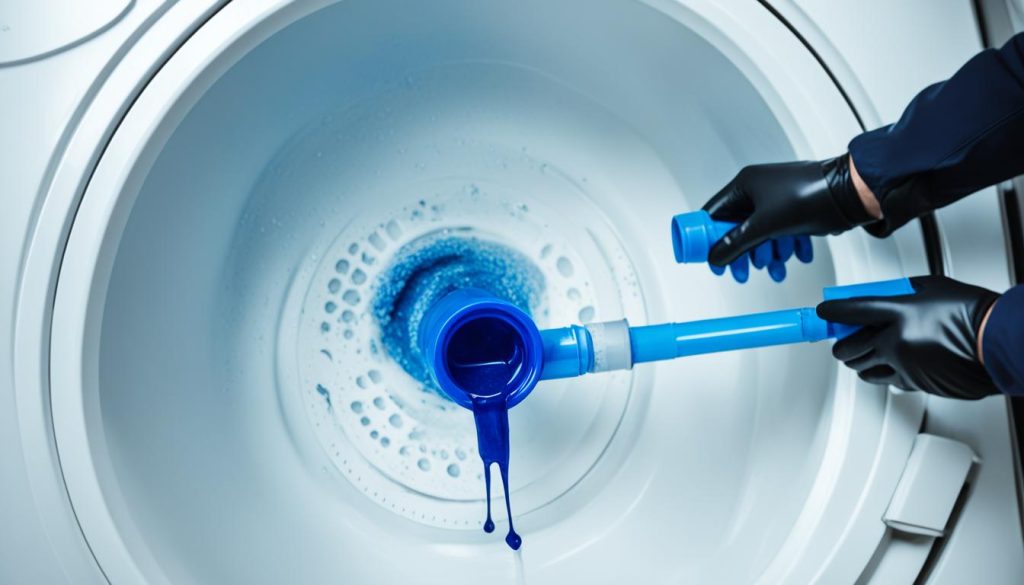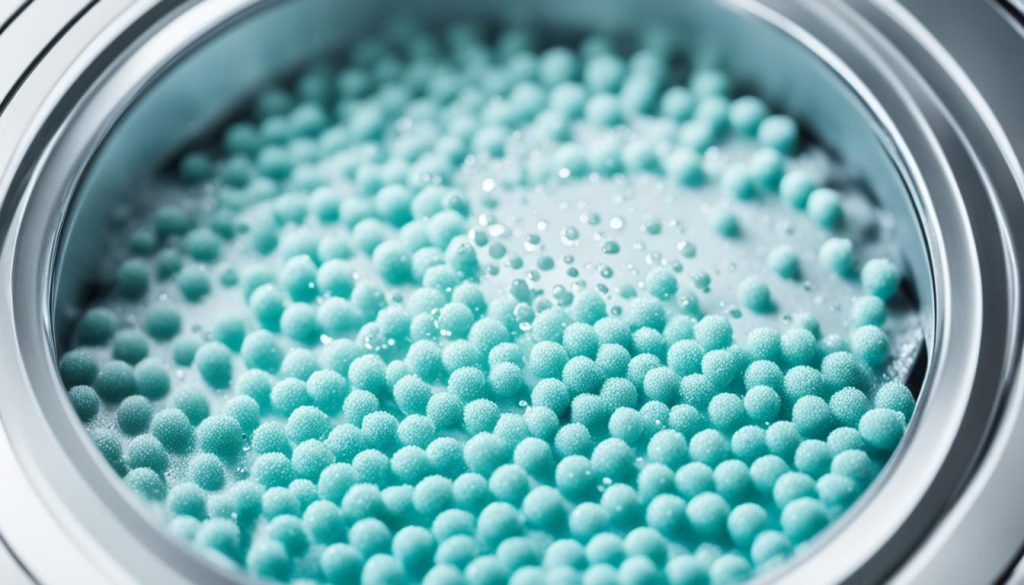Drain Washing Machine: Easy Cleaning Guide
If you’ve ever experienced the frustration of a washing machine that refuses to drain, you’re not alone. A clogged drain is a common issue that can disrupt your laundry routine and even lead to costly repairs. But fear not, because I’m here to guide you through the process of draining your washing machine effectively, ensuring smooth and hassle-free laundry days.
Key Takeaways:
- Regularly cleaning and maintaining your washing machine drain can prevent clogs and malfunctions.
- Disconnect the drain hose from the back of the machine to access and clear any blockages.
- Use a drain auger or commercial drain cleaner to remove stubborn clogs.
- Clean the washing machine filter to remove debris and improve drainage.
- Consider using natural methods such as baking soda and vinegar to clear minor blockages in the drain hose.
How to Disconnect the Drain Hose
Before cleaning the drain pipe, it’s important to disconnect the drain hose from the washing machine. Follow these simple steps to disconnect the drain hose:
- Start by shutting off the water supply lines.
- Grab towels to soak up any water that may spill during the disconnection process.
- If necessary, slide the washer out from the wall to access the supply lines.
- Locate the plastic drain hose coming out of the back of the machine.
- Use pliers or channel locks to unlock the round clamp at the base of the hose.
- Wiggle the hose out of the machine, or cut off any zip ties holding it to the sink if applicable.
- If the hose drains into a pipe in the wall, unscrew or release any brackets or connectors to remove the hose from the drain.
By following these steps, you’ll be able to disconnect the drain hose efficiently and safely.
How to Clear Blockages in the Drain Hose
Once the drain hose is removed, it’s important to check for any blockages inside. To do this, use a flashlight to inspect the hose. Look for any debris, dirt, or clogs that may be causing the blockage.
If you find a blockage, there are a few options for clearing it. One method is to use a drain auger. Slowly insert the drain auger into the hose and gently move it around to feel for any resistance. If you encounter a blockage, twist the handle of the drain auger clockwise to collect the sediment or dirt. Remove the drain auger and pull off the blockage from the wire. Repeat this process until you no longer feel any resistance in the hose.
Another option is to use a commercial drain cleaner. Follow the manufacturer’s instructions and apply the cleaner to the affected area. Let the cleaner sit for the specified time before flushing it out with water. This can help dissolve the blockage and clear the drain hose.
Remember, cleaning the drain hose regularly can help prevent blockages from occurring in the first place. It’s a good idea to clean the hose at least once every six months to ensure proper drainage and prevent any potential issues.
Methods for Clearing Blockages in the Drain
When faced with a clogged washing machine drain, there are several effective methods you can try to clear the blockage and restore proper drainage. Here are some tried-and-tested techniques:
Pouring Hot Water
One simple method to clear minor clogs caused by soap buildup is to pour hot water down the drain or hose. The heat can help dissolve the soap and wash away any debris that may be obstructing the flow.
Baking Soda and Vinegar
A natural and eco-friendly solution involves using a combination of baking soda and vinegar. Start by pouring half a cup of baking soda down the drain, followed by one cup of vinegar. This mixture will create a fizzing reaction that can help break down soap scum and clear blockages. After allowing the mixture to sit for about 15 minutes, flush the drain with hot water to rinse away any remaining debris.
Commercial Drain Cleaner
If the blockage persists despite your attempts with hot water and natural remedies, you can opt for a commercial drain cleaner. However, it is essential to choose a cleaner that is safe for your specific pipe material and drainage system. Some drain cleaners contain harsh chemicals like sulfuric acid, which can damage PVC pipes and have negative environmental impacts.
The choice of method depends on the severity of the blockage and your preference for natural or commercial solutions. It’s important to note that if the clog is particularly stubborn or if you are unsure about handling the issue yourself, it is recommended to seek assistance from a professional plumber.
| Method | Pros | Cons |
|---|---|---|
| Pouring Hot Water | – Simple and cost-effective – Can help clear minor clogs |
– May not be effective for severe blockages – Limited impact on stubborn debris |
| Baking Soda and Vinegar | – Natural and eco-friendly – Can dissolve soap scum and remove blockages |
– May not work for all types of clogs – Requires additional rinsing with hot water |
| Commercial Drain Cleaner | – Potentially stronger and more effective – Convenient option for persistent clogs |
– Contains harsh chemicals – Potential damage to pipes and environment |
How to Clean the Washing Machine Filter
Regular maintenance of the washing machine filter is crucial, especially for older models. The filter can be located in various places such as at the end of the drain hose, along the drum rim, under the agitator cover, or in a small hatch on the outside of the machine.
To clean the washing machine filter, follow these steps:
- Locate the filter based on your machine’s model and design.
- Gently remove the filter from its housing.
- Rinse the filter thoroughly with water to remove any dirt or debris trapped in the mesh.
- Inspect the filter for any signs of damage. If broken or worn out, consider replacing it with a new one.
- Once the filter is clean and in good condition, reattach it securely to its original position.
- Run a test cycle to ensure the proper functioning of the washing machine and smooth drainage.
Washing Machine Filter Maintenance Tips:
- Clean the filter at least once every few months to prevent blockages and ensure optimal performance.
- Check the manufacturer’s instructions or the appliance manual for specific guidance on filter maintenance for your machine.
- If you notice persistent drainage problems even after cleaning the filter, it may be necessary to contact a professional appliance repair person for further assistance.
Comparison of Washing Machine Filter Locations
| Filter Location | Advantages | Disadvantages |
|---|---|---|
| End of the drain hose | Easily accessible for cleaning | May require removing the hose to access the filter |
| Along the drum rim | Filters out larger debris effectively | Difficult to reach and clean manually |
| Under the agitator cover | Filters out small particles | Requires disassembling the agitator to access the filter |
| In a small hatch on the outside of the machine | Quick and easy access for cleaning | Filter may be prone to clogging due to its location |
How to Clean a Front-Load Washing Machine
To keep your front-load washing machine functioning at its best, regular cleaning is essential. Here’s a step-by-step guide on how to clean your front-load washer and maintain its performance:
- Pull the machine away from the wall: Start by gently pulling the washing machine away from the wall to access the back and sides of the unit.
- Locate and disconnect the drain: Find the drain at the back of the machine and disconnect it. Allow any excess water to drain out before proceeding with the cleaning process.
- Check for debris: Inspect the drain for any debris or obstructions. If you notice any, use a drain snake or a similar tool to remove the blockage and ensure proper drainage.
- Soak the drain in vinegar: Fill a container with vinegar and submerge the drain in it. Let it soak for a few hours to remove any mildew or buildup.
- Scrub stubborn grime with baking soda: Dip an old toothbrush into baking soda and scrub away any stubborn grime or residue around the drain, door, and rubber seals.
- Wipe away residue: Use a damp cloth to wipe away any remaining residue after scrubbing. Pay attention to the inside of the drum, the door, and the detergent dispenser.
- Refresh the drum: For a quick refresh, spritz the inside of the drum with white vinegar and wipe it down using a microfiber cloth.
- Deep clean the machine: To deep clean the interior of the washing machine, run a cycle with vinegar and lavender essential oil or a mixture of washing soda and borax. Follow the manufacturer’s instructions for recommended amounts and program settings.
Regularly cleaning your front-load washing machine not only improves its performance but also helps eliminate odors and keeps your clothes fresh and clean. Follow these cleaning steps every few months to maintain a hygienic and efficient laundry routine.
How to Clean a Top-Load Washing Machine
Cleaning your top-load washing machine regularly is essential to keep it running smoothly and to maintain the cleanliness of your clothes. Follow these simple steps to ensure a clean and fresh machine.
Start by setting your washing machine to the highest and hottest water setting. This will help to loosen any built-up dirt and grime. Next, add white vinegar to the drum and run a cycle to soak the machine. Vinegar is a natural cleaning agent that helps to remove odors and stains.
Once the vinegar cycle is complete, pause the machine and add baking soda. Baking soda is a powerful deodorizer and can help to eliminate any lingering smells. Resume the cycle and let it run on the highest and hottest settings.
After the cycle is complete, leave the top of the machine open to allow it to air dry. This will help to prevent any moisture build-up, which can lead to mold and mildew growth. Once the machine is dry, wipe down the inside with a clean cloth.
To further enhance the cleanliness of your top-load washing machine, run a cycle with distilled white vinegar. Simply pour the vinegar into the liquid detergent dispenser and run a hot water cycle. This will help to remove any remaining residue and keep your machine fresh.
For a deep clean, you can also use a combination of washing soda and borax in place of vinegar. These powerful natural cleaners will ensure a thorough cleaning of your machine. Just add them to the drum and run a full cycle on the highest and hottest settings.
By following these simple steps, you can keep your top-load washing machine clean and well-maintained, ensuring optimal performance and fresh-smelling laundry every time.
- Investing Wisely: How Windows & Doors in Boost Property Value and Financial Health - April 24, 2025
- The Financial Impact of Personal Injuries: Why Legal Help Matters for Business Owners - April 16, 2025
- The Hidden Financial Costs of Domestic Assault: What Business Owners Need to Know - April 16, 2025














